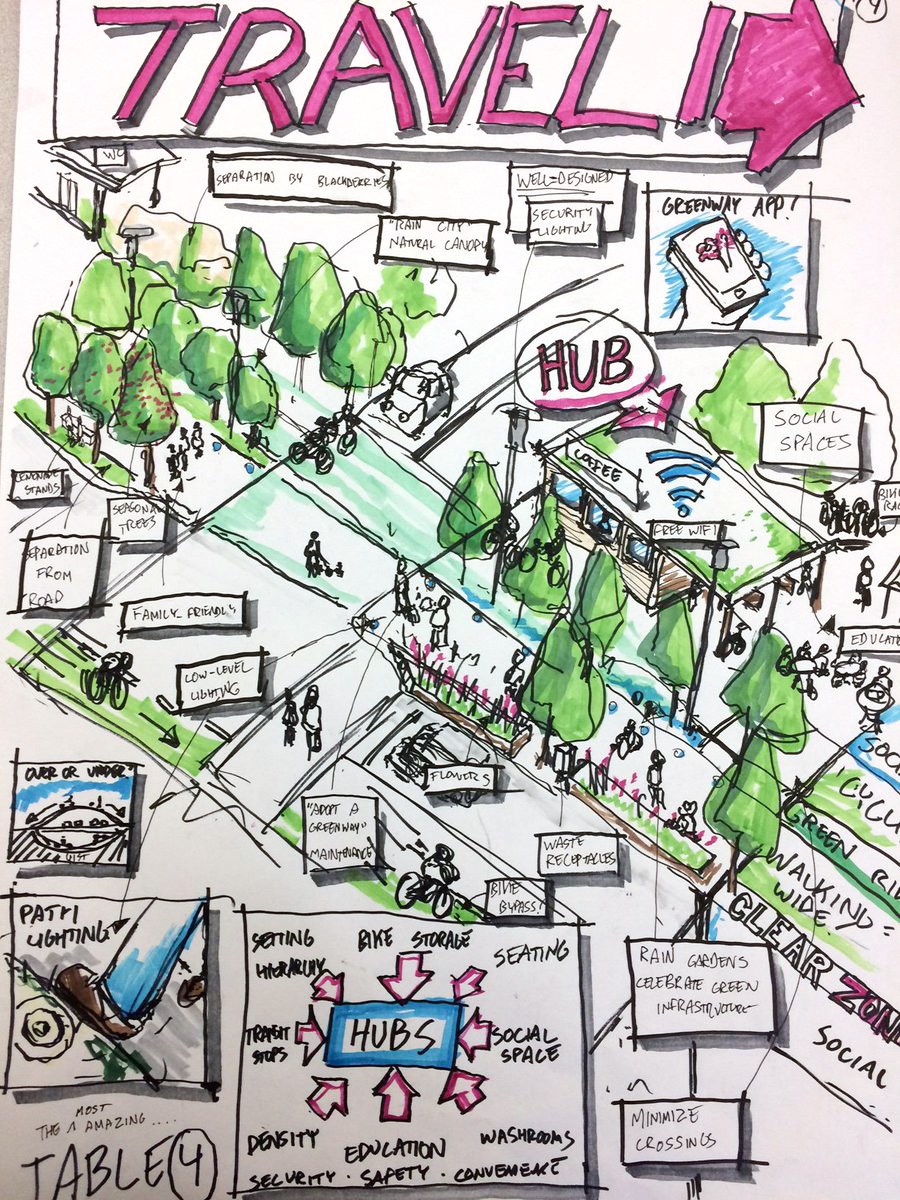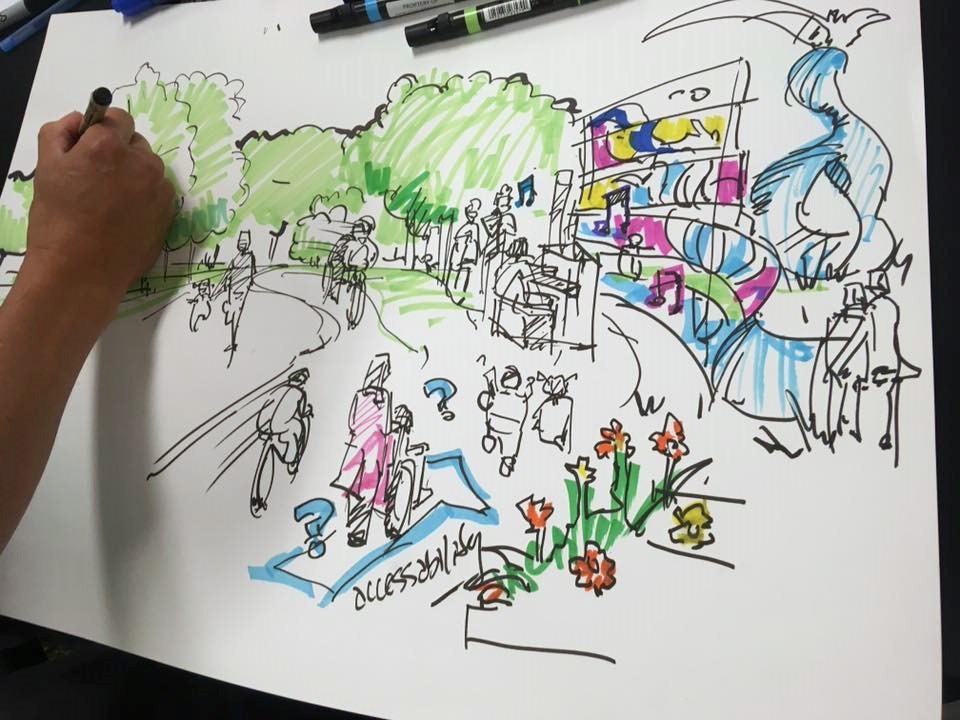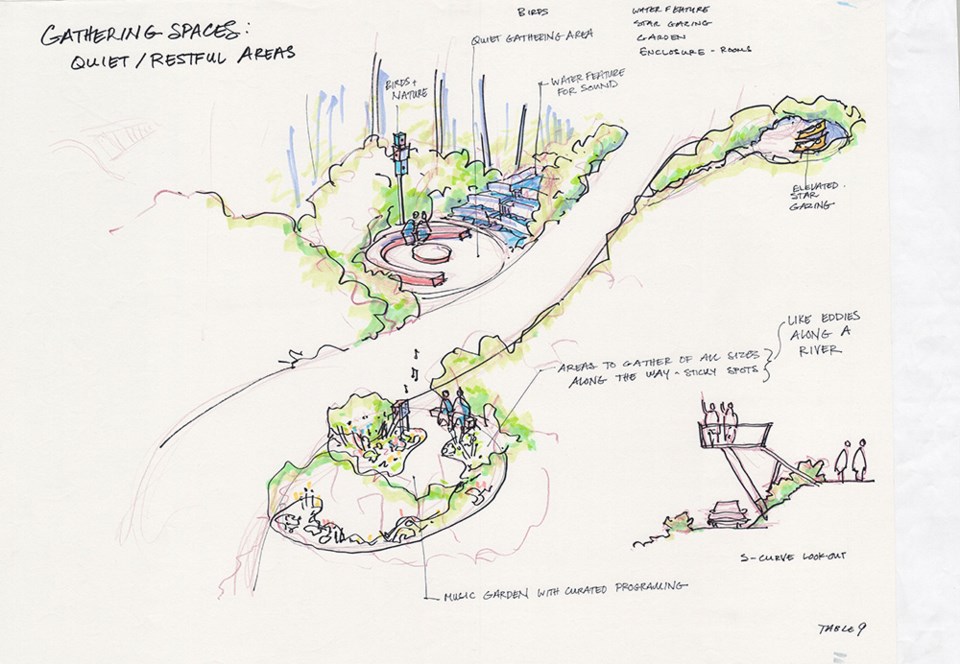Good lighting for safe travel. Bike facilities. Rooms and experiences along the route to reflect local character. Oversize chess pieces to play with in public spaces. Seasonal food trucks and seating areas to dine al fresco. Educational displays. Water features and rainwater collection.
These were among ideas pitched by participants of the City of Vancouver-run “design jam,” as well as other consultation sessions, held about the Arbutus Greenway late last year.
During the design jam, more than 100 people, aged 18 and over, selected from 22 neighbourhoods across Vancouver, worked with city staff and technical experts to dream up design possibilities for the nine-kilometre route.
A report, which gives insight into the conversations that took place at the design jam, and input from the other public consultation sessions, was released Feb. 2. It includes emerging design ideas being considered. (Read the report here. Click here for our article on the route of a future streetcar.)
Maggie Buttle, senior project manager for the Arbutus Greenway project, said dozens of practical ideas were voiced about how people want to use the transportation corridor and what features and amenities they’d like.
Aside from practical suggestions, such as lighting and bike facilities, Buttle said participants also proposed “big, bold ideas.”
“One thing that was particularly great was how they’d like to see different experiences as they progress over the nine kilometres. They felt it would be nice if they had rooms and experiences that would reflect the local character of the place,” she said.
Others thought the greenway could be an educational journey featuring things such as beehive displays or information about subjects like native plantings, “so it’s an educational journey as well as transportation journey.”
No idea was considered too impractical.
“There were lots of ideas for having high look-out points, using those for opportunities, how we can use water features for the greenway. Some ideas, it’s not that they were bad ideas, it’s how we can practically use them in certain locations on the greenway — how we can integrate people of all ages to play along the greenway,” she said.
All suggestions were synthesized into a handful of themes, including transportation, public space, urban ecology, urban agriculture, and local history and culture.
The transportation theme focused on how people want to use and access the greenway, with participants pointing out they want safe and convenient ways of travelling for all ages and abilities, according to Buttle. Participants also talked about surface material.

Discussions around public space centred on how people want to interact together, how they can be social and meet their neighbours there.
“How they can play, sit and relax, how they can have public art … a lot of those amenities and experiences came out in that discussion,” she said, citing examples such as the chess board and ensuring there are areas where kids can safely play adjacent to the greenway, as well as reserving space for performances.
Participants also stressed the importance of nature, biodiversity, setting aside space for urban agriculture and the restoration of habitat along the greenway. Examples include scented plantings, butterfly bush, bird-nesting boxes and a variety of trees for different species of birds.
“As we know, our community gardens are an important aspect in this greenway and will continue to be in the future. [Discussions included] how we integrate food production in our design, integrate that into the landscape,” Buttle said.
The greenway project team has been working with the Musqueam, Squamish and Tsleil-waututh Nations at a government-to-government level about how their cultures can be reflected within the design.
“What we’ve heard was [the importance of] opportunities to reinvigorate this greenway for native plantings and the opportunity for public art of all forms but especially Indigenous art,” Buttle said. “Those conversations are continuing on a government-to-government basis.”
How the design team will accommodate all the suggestions along a corridor that is, on average, 20 metres wide remains to be seen, but Buttle is optimistic about what’s possible. A preferred design concept, based on the emerging ideas, will be released this spring and public feedback will be sought to refine the design.
“The team is going to have make some trade-offs and priorities and that’s why we’re really excited about when we go back to the public in the spring and we can hear from people [if we got] it right,” she said.

Space is not the only consideration; costs and funding will have to be addressed once the final design is selected. Estimates haven’t been calculated yet because the design process is still underway. Aside from gathering feedback at the design jam, the city also collected comments at open houses that attracted 540 people, community input sessions that 238 people attended, and from the technical committee.
“The exciting thing about Arbutus Greenway is that it is nine kilometres. We do have a great opportunity where we can put a lot of these ideas in place along the greenway, but there’s always going to be financial constraints,” Buttle said. “We have to figure out what is the funding available to us and how we can put everything that people want and desire into this greenway. But an opportunity that we have, by building this greenway over a longer period of time, is it will allow us to fund different sections of this greenway and have everyone see their ideas come to fruition.”
A report with recommendations, costs and an implementation plan, will go before council for consideration this summer.
@naoibh
noconnor@vancourier.com



